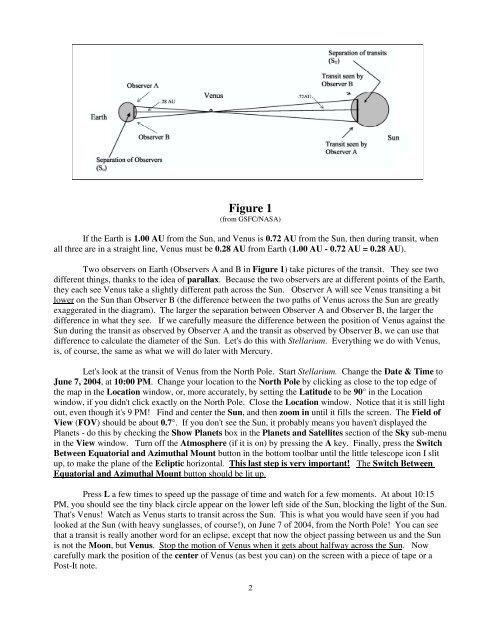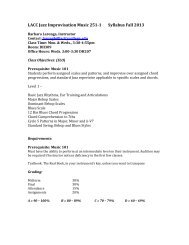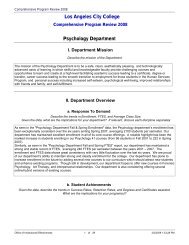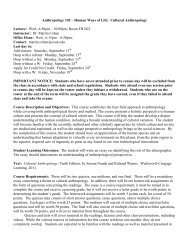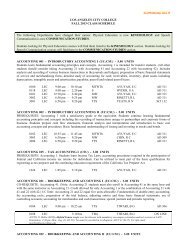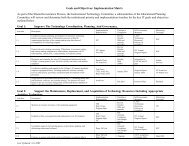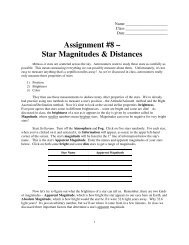Assignment #7 – Transits of Venus & Mercury - Faculty Web Pages
Assignment #7 – Transits of Venus & Mercury - Faculty Web Pages
Assignment #7 – Transits of Venus & Mercury - Faculty Web Pages
You also want an ePaper? Increase the reach of your titles
YUMPU automatically turns print PDFs into web optimized ePapers that Google loves.
Figure 1<br />
(from GSFC/NASA)<br />
If the Earth is 1.00 AU from the Sun, and <strong>Venus</strong> is 0.72 AU from the Sun, then during transit, when<br />
all three are in a straight line, <strong>Venus</strong> must be 0.28 AU from Earth (1.00 AU - 0.72 AU = 0.28 AU).<br />
Two observers on Earth (Observers A and B in Figure 1) take pictures <strong>of</strong> the transit. They see two<br />
different things, thanks to the idea <strong>of</strong> parallax. Because the two observers are at different points <strong>of</strong> the Earth,<br />
they each see <strong>Venus</strong> take a slightly different path across the Sun. Observer A will see <strong>Venus</strong> transiting a bit<br />
lower on the Sun than Observer B (the difference between the two paths <strong>of</strong> <strong>Venus</strong> across the Sun are greatly<br />
exaggerated in the diagram). The larger the separation between Observer A and Observer B, the larger the<br />
difference in what they see. If we carefully measure the difference between the position <strong>of</strong> <strong>Venus</strong> against the<br />
Sun during the transit as observed by Observer A and the transit as observed by Observer B, we can use that<br />
difference to calculate the diameter <strong>of</strong> the Sun. Let's do this with Stellarium. Everything we do with <strong>Venus</strong>,<br />
is, <strong>of</strong> course, the same as what we will do later with <strong>Mercury</strong>.<br />
Let's look at the transit <strong>of</strong> <strong>Venus</strong> from the North Pole. Start Stellarium. Change the Date & Time to<br />
June 7, 2004, at 10:00 PM. Change your location to the North Pole by clicking as close to the top edge <strong>of</strong><br />
the map in the Location window, or, more accurately, by setting the Latitude to be 90° in the Location<br />
window, if you didn't click exactly on the North Pole. Close the Location window. Notice that it is still light<br />
out, even though it's 9 PM! Find and center the Sun, and then zoom in until it fills the screen. The Field <strong>of</strong><br />
View (FOV) should be about 0.7°. If you don't see the Sun, it probably means you haven't displayed the<br />
Planets - do this by checking the Show Planets box in the Planets and Satellites section <strong>of</strong> the Sky sub-menu<br />
in the View window. Turn <strong>of</strong>f the Atmosphere (if it is on) by pressing the A key. Finally, press the Switch<br />
Between Equatorial and Azimuthal Mount button in the bottom toolbar until the little telescope icon I slit<br />
up, to make the plane <strong>of</strong> the Ecliptic horizontal. This last step is very important! The Switch Between<br />
Equatorial and Azimuthal Mount button should be lit up.<br />
Press L a few times to speed up the passage <strong>of</strong> time and watch for a few moments. At about 10:15<br />
PM, you should see the tiny black circle appear on the lower left side <strong>of</strong> the Sun, blocking the light <strong>of</strong> the Sun.<br />
That's <strong>Venus</strong>! Watch as <strong>Venus</strong> starts to transit across the Sun. This is what you would have seen if you had<br />
looked at the Sun (with heavy sunglasses, <strong>of</strong> course!), on June 7 <strong>of</strong> 2004, from the North Pole! You can see<br />
that a transit is really another word for an eclipse, except that now the object passing between us and the Sun<br />
is not the Moon, but <strong>Venus</strong>. Stop the motion <strong>of</strong> <strong>Venus</strong> when it gets about halfway across the Sun. Now<br />
carefully mark the position <strong>of</strong> the center <strong>of</strong> <strong>Venus</strong> (as best you can) on the screen with a piece <strong>of</strong> tape or a<br />
Post-It note.<br />
2


